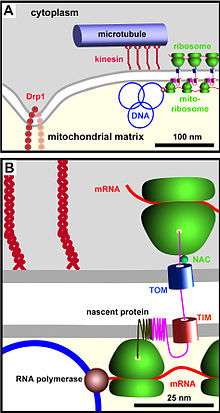TIM/TOM complex

The TIM/TOM complex is a process in cellular biochemistry which describes the translocation of proteins produced from nuclear DNA through the mitochondrial membrane for use in oxidative phosphorylation. Only 13 proteins necessary for a mitochondrion are actually coded in mitochondrial DNA.
The vast majority of proteins destined for the mitochondria are encoded in the nucleus and synthesized in the cytoplasm. These are tagged by an N-terminal signal sequence. Following transport through the cytosol from the nucleus, the signal sequence is recognized by a receptor protein in the translocase of the outer membrane (TOM) complex. The signal sequence and adjacent portions of the polypeptide chain are inserted in the TOM complex, then begin interaction with a translocase of the inner membrane (TIM) complex, which are hypothesized to be transiently linked at sites of close contact between the two membranes. The signal sequence is then translocated into the matrix in a process that requires an electrochemical hydrogen ion gradient across the inner membrane. Mitochondrial Hsp70 binds to regions of the polypeptide chain and maintains it in an unfolded state as it moves into the matrix.[1]
TIC/TOC Complex vs. TIM/TOM Complex
This protein complex is functionally similar to the TIC/TOC Complex located on the inner and outer membranes of the chloroplast, in the sense that it transports proteins into the membrane of the mitochondria.[2]
References
External links
- Overview of the various import ways into mitochondria (group of N. Pfanner)